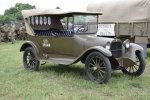Cool video but that has nothing to do with left lugnuts.
Yes it does and How many Dodge trucks went to war beginning 1916?
It is a Dodge invention?
Chrysler products began using left handed threads in the late 1930's and phased out their use during the 1971 model year. Mopars for many years and tossing the left hand threads was one of first thing I would do when building my race cars.
A '36 Dodge touring Sedan and the front left and rear lug nuts are left threaded. Chrysler did this to assure the owner the lug nut would be tight all the time. They are marked with an L (left thread) and R (right). Hope this answer helps to prevent broken knuckles.
Actually Chysler that did this. The reason for it? I gross misunderstanding of the way in which fasteners work (and the way in which people don't) lead some engineering genius to conclude that the lug nuts should turn against the rotation direction of the wheel. This might make some small amount of since from the viewpoint of any individual lug nut, if the nut were large (in mass) in comparison to the wheel, such that there is some possibility that the inertia of the nut might create a significant D'Alembert torque to loosen the nut, but in fact the nut is so light in comparison to the wheel, and the forces are sufficiently symmetrically balanced that this is not an issue.
The engineering wisdom behind these “backward” wheel fasteners is no doubt based in the concept that inertia on the driver side of the vehicle could hypothetically act to loosen a conventional right-hand fastener as the vehicle accelerates and brakes while moving forward. A similar strategy is employed on most bicycle pedals: the left-hand pedal and crank end having left-hand threads. Here it works great to keep the pedal from unscrewing while you ride and has contributed to a worldwide shortage of choirboys. But when it comes to cars, there are dubious benefits as proven by the fact that GM, and yes even Mopar, eventually abandoned the use of these wacky fasteners.
When you have 5 lug nuts, the nuts do not unscrew as the car goes down the road, no matter which way the threads go. But it DID matter on stage coaches and covered wagons, which had only one nut. Early cars had LH and RH threads because mechanics who worked on both cars and wagons EXPECTED LH and RH threads. As wagons faded out, the practice continued, until there were more people confused by LH threads.
Nope, I have not found the patent yet.................
The concept may have stemmed from the "knock off hubs" where there is a large mass with some inertia when in motion, like an MGB MGC









